“The future belongs to those who believe in the beauty of their dreams,” said Eleanor Roosevelt. This sentiment rings true for China’s rapid advancements in artificial intelligence, a field reshaping industries and innovation globally. With a market valued at $23.196 billion in 2021, China’s AI sector is projected to triple by 2025, driven by significant government investments and regulatory measures1.
Major companies are at the forefront of this transformation, setting trends and pushing boundaries. From Shenzhen’s high-performance computing centers to Beijing’s ambitious goals of global leadership, the nation’s AI ecosystem is thriving1. Regulatory frameworks, such as the “Measures for Generative AI Services,” ensure ethical development while fostering growth2.
This article explores the balance between technological breakthroughs and government oversight, offering insights into trends, case studies, and future opportunities. Discover how China’s AI landscape is shaping the global stage.
Key Takeaways
- China’s AI market is set to triple by 2025, driven by innovation and investment.
- Major cities like Beijing and Shenzhen lead in AI infrastructure and development.
- Government regulations ensure ethical AI growth while fostering innovation.
- Companies play a pivotal role in driving advancements and setting market trends.
- China aims to become a global AI leader by 2030, supported by strategic policies.
Introduction to China’s AI Landscape

Government-backed initiatives are driving China’s AI dominance. With a focus on innovation and regulation, the nation is setting global benchmarks in the field. Strategic investments and robust policies have created a thriving ecosystem that integrates technology with traditional industries3.
Since 2021, early regulatory efforts, such as the enforcement of deep synthesis provisions, highlight China’s proactive approach. These measures ensure ethical development while fostering growth4. The fusion of technology and regulation has positioned China as a leader in artificial intelligence.
China’s AI market is projected to triple by 2025, driven by significant investments and innovation. Major cities like Beijing and Shenzhen are at the forefront, hosting high-performance computing centers and ambitious projects3. The government plays a pivotal role in steering this growth, ensuring a balance between breakthroughs and oversight.
Key data points illustrate this progress. For instance, the core AI industry is expected to exceed $140 billion by 2030, with related sectors reaching $1.4 trillion4. These figures underscore the scale of China’s ambitions and its impact on the global stage.
This section sets the stage for deeper insights into trends, regulatory impacts, and company case studies. By understanding the foundation of China’s AI landscape, readers can better appreciate its global influence and future potential.
How to Understand China’s AI Landscape
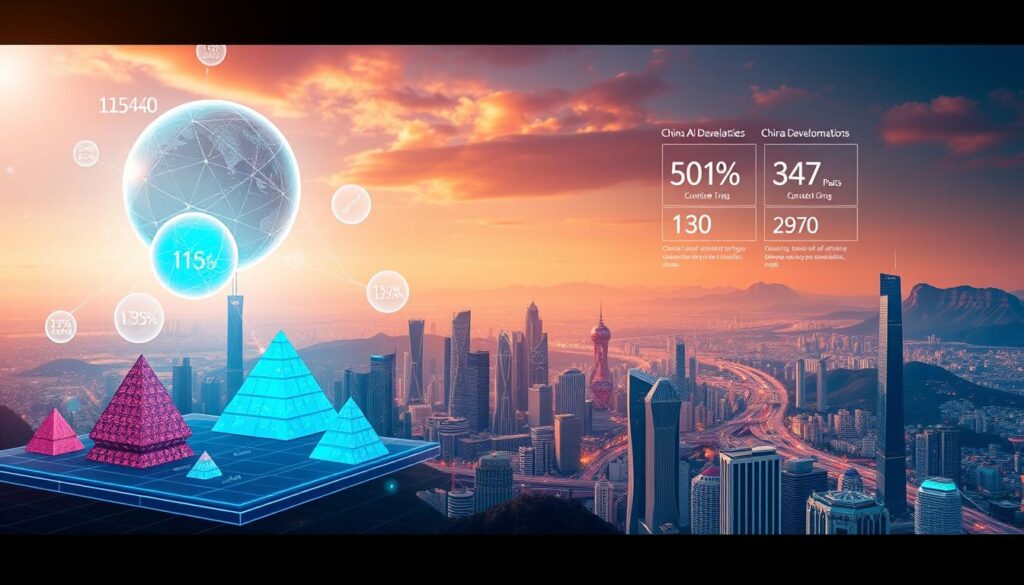
China’s advancements in artificial intelligence are reshaping global innovation, driven by rapid development and strategic investments. The nation now produces more AI research than the United States, highlighting its evolving industry5.
Key metrics reveal the scale of this progress. For instance, the core AI sector is projected to exceed $140 billion by 2030, with related industries reaching $1.4 trillion6. These figures underscore the ambition behind China’s AI strategies.
Development milestones are equally significant. Companies like Baidu and Tencent are leading in self-driving technology and healthcare innovations, respectively5. Meanwhile, startups are pushing boundaries with large language models, narrowing the gap with international competitors7.
Industry-specific factors also play a crucial role. The integration of AI into healthcare, finance, and surveillance is transforming traditional sectors, enhancing diagnostics, risk assessment, and law enforcement5.
- Metrics like research output and investment highlight China’s AI growth.
- Development milestones showcase the progress of leading firms.
- Industry-specific applications demonstrate AI’s transformative potential.
This section sets the stage for deeper insights into regulatory impacts and market trends, offering a comprehensive view of China’s AI landscape.
Key Trends in China’s Artificial Intelligence Industry
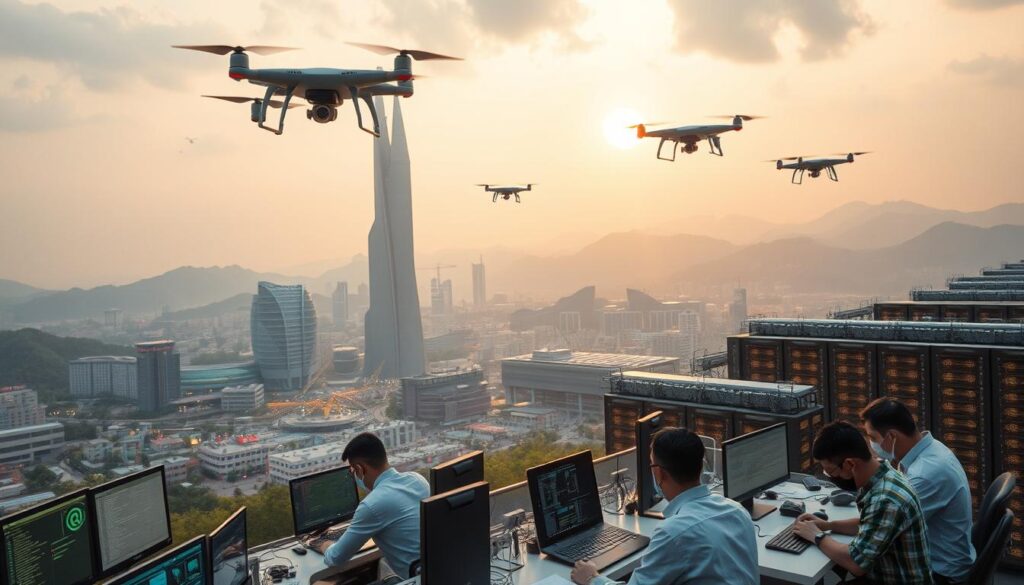
Innovation in artificial intelligence is accelerating across China, fueled by groundbreaking research and strategic investments. The market is witnessing rapid growth, with over 180 large language models approved for public use8. These advancements are reshaping industries and setting new global standards.
AI Model Development and Research Breakthroughs
Breakthroughs in AI research are transforming the application of technology in real-world scenarios. For instance, Huawei Cloud’s Ascend service reduced large model training time from five months to one month9. This efficiency is driving adoption across sectors like healthcare and finance.
Government policy plays a crucial role in shaping these advancements. The “Interim Measures for the Management of Generative Artificial Intelligence Services” introduced in 2023 ensures ethical development while fostering innovation9. These measures balance growth with accountability.
Private investment in generative AI surged from $650 million in 2023 to $3.15 billion in 2024, reflecting a five-fold increase9. This funding supports cutting-edge projects, such as Baidu’s ERNIE Bot, which holds an 11.5% market share among domestic users9.
China’s AI development faces challenges, including export controls on advanced semiconductors and fragmented data availability9. Despite these hurdles, the nation remains a global leader in AI patents and scientific contributions9.
- Over 180 large language models approved for public use8.
- Private investment in generative AI grew five-fold in 20249.
- Government policy ensures ethical AI development9.
- Cutting-edge projects like Baidu’s ERNIE Bot lead the market9.
These trends highlight the interplay between market forces, policy frameworks, and technological innovation. As China continues to push boundaries, its AI advancements will shape global competition and collaboration.
The Role of Government and Regulation in China’s AI Development

Government policies have become the backbone of China’s rapid progress in artificial intelligence, shaping its global influence. National-level measures, including strict regulation on deepfake technology and personalized recommendation algorithms, have been in force since 202110. These policies ensure ethical development while fostering innovation.
Over the years, China’s regulatory frameworks have evolved significantly. The “Internet Information Service Algorithmic Recommendation Management Provisions” introduced in 2021 marked a turning point, emphasizing transparency and accountability11. These measures have shaped intelligence systems, ensuring they align with national priorities.
Training programs have also played a crucial role. Government-backed initiatives have expanded access to training in AI technologies, creating a skilled workforce10. This focus on education has been instrumental in driving advancements and narrowing the gap with global competitors.
Regulation has become both a driver and inhibitor of technology growth. While policies like the “Provisional Measures for the Administration of Generative Artificial Intelligence Services” foster innovation, they also impose strict compliance requirements12. This dual role ensures a balance between progress and oversight.
China’s approach to AI governance reflects its broader strategic ambitions. By 2030, the nation aims to lead global AI development, supported by comprehensive regulatory frameworks10. These efforts highlight the government’s commitment to shaping the future of intelligence technologies.
For more insights into global AI governance, explore this detailed analysis.
China’s Deep Synthesis Provisions and Their Impact

China’s regulatory framework for AI-generated content is setting new standards for ethical innovation. On January 10, 2023, the Deep Synthesis Provisions took effect, aiming to regulate deepfake technology and synthetic media for 1.4 billion people13. These measures reflect the government’s commitment to balancing technological growth with risk mitigation.
Understanding the Regulatory Measures
The Deep Synthesis Provisions require service providers to verify user identities through mobile phone numbers or national online authentication services13. This initiative ensures accountability and transparency in the use of AI-generated content. Additionally, providers must establish rumor refutation mechanisms and user complaint systems, ensuring timely feedback13.
These regulations are supported by a robust legal framework, including the Cybersecurity Law and Personal Information Protection Law13. By integrating science technology with legal oversight, China is fostering a secure environment for AI innovation.
Implications for AI-Generated Content
The provisions mandate explicit labeling for AI-generated materials that may cause public confusion13. This initiative helps maintain trust in digital content while promoting ethical practices. Content creators must now navigate these regulations, ensuring compliance without stifling creativity.
The government’s focus on growth in AI-generated content is evident in its support for research and development. By 2030, China aims to lead globally in AI innovation, supported by these regulatory measures14.
| Regulatory Measure | Impact |
|---|---|
| User Identity Verification | Enhances accountability and transparency |
| Rumor Refutation Mechanism | Ensures timely response to misinformation |
| Explicit Labeling | Maintains public trust in AI-generated content |
For more insights into AI tools and their applications, explore this detailed analysis.
Policy and Regulatory Framework in China’s Digital Sphere

China’s digital policies are shaping the future of technology with a focus on ethical innovation. The landscape is defined by a combination of strict controls and forward-thinking regulations, ensuring both growth and accountability15.
In late 2021, China introduced the world’s first comprehensive regulation for algorithmic recommendation systems, setting a global precedent15. This approach emphasizes transparency and user protection, aligning with international standards like the EU’s Digital Markets Act (DMA).
Deepfake technologies are also under scrutiny. In early 2023, the Cyber Space Administration of China (CAC) implemented measures to curb the production of synthetic media, making China the first country to regulate this area15. These steps highlight the government’s proactive stance on mitigating risks associated with AI advancements.
Algorithmic Recommendation and Deepfake Regulation
The control mechanisms in place are designed to monitor and mitigate harmful AI outputs. For instance, generative AI services that shape public opinion must undergo a security assessment and register their algorithms with the CAC before launch15. This ensures accountability and reduces the spread of misinformation.
China’s regulatory approach differs from Western models by prioritizing rapid implementation. Between 2020 and 2022, Chinese authorities imposed sanctions on tech firms with unprecedented speed, reflecting a commitment to maintaining a balanced digital ecosystem15.
These policies have a significant impact on domestic technology firms. Companies like Tencent and Ant Group faced restrictions on integrating advanced AI tools, such as ChatGPT, into their platforms15. While these measures ensure compliance, they also challenge firms to innovate within regulatory boundaries.
Globally, China’s regulatory landscape is influencing market competition. By setting high standards for ethical AI development, China is positioning itself as a leader in responsible technology innovation15.
The evolution of this landscape reflects a broader commitment to fostering innovation while ensuring public trust. As China continues to refine its policies, its influence on the global stage will only grow15.
Emerging AI Applications and Industry Innovations

China’s sector-specific AI applications are revolutionizing industries, driving efficiency, and fostering innovation. From finance to smart manufacturing, tailored solutions are addressing unique market needs, supported by robust government and industry collaboration16.
In the finance sector, AI-powered tools are enhancing risk assessment and fraud detection. Companies like Tencent and Alibaba are leveraging AI to streamline operations and improve customer experiences16. This support from tech giants is accelerating the adoption of advanced technologies.
Biopharmaceuticals are also benefiting from AI innovations. AI-driven drug discovery platforms are reducing development timelines and costs. For instance, AI models are being used to predict drug efficacy, significantly improving processing speeds17.
Remote sensing applications are transforming industries like agriculture and environmental monitoring. AI algorithms analyze satellite data to provide actionable insights, improving crop yields and resource management18. These advancements are supported by government guidance and funding initiatives.
Smart manufacturing is another area where AI is making a significant impact. Harbin Electric’s AI-powered welding robots have improved production efficiency by 40%, while Xiaomi’s automated car manufacturing plant produces a new car every 76 seconds18. These innovations highlight the role of tailored applications in enhancing productivity.
| Sector | AI Application | Impact |
|---|---|---|
| Finance | Risk Assessment | Improved fraud detection and operational efficiency |
| Biopharmaceuticals | Drug Discovery | Reduced development timelines and costs |
| Remote Sensing | Agriculture Monitoring | Enhanced crop yields and resource management |
| Smart Manufacturing | Automated Production | Increased efficiency and productivity |
These sector-specific applications demonstrate how AI is transforming traditional industries. With continued support and guidance, China’s AI ecosystem is poised to lead global innovation16.
China’s AI Market Growth and Economic Projections
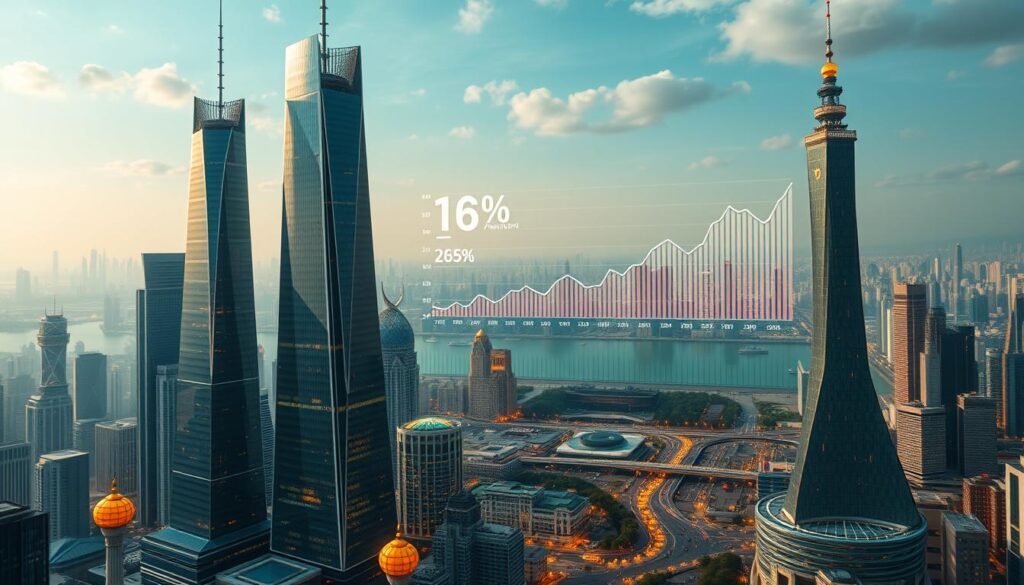
China’s tech sector is booming, with artificial intelligence driving unprecedented economic growth. Market projections indicate a rise from $23.196 billion in 2021 to an estimated $61.855 billion by 2025, with expectations of $154.638 billion in AI revenue by 203019. This growth is fueled by significant investments and tech advancements.
The opportunity for expansion is immense, driven by innovations in machine learning, natural language processing, and generative AI20. Companies are leveraging these technologies to enhance efficiency and create new revenue streams. For instance, AI-powered solutions in healthcare and finance are transforming traditional industries19.
Government and private sector efforts are pivotal in this growth. The Bank of China plans to provide 1 trillion Yuan in funding to AI companies over the next five years21. This financial backing supports cutting-edge projects and attracts global attention.
Breakthrough innovations are also attracting significant investment. For example, DeepSeek trained its AI model for under $6 million, showcasing cost-effective tech development21. Such advancements are narrowing the gap with international competitors and driving market expansion.
The economic impact of AI extends beyond China’s borders. By 2030, the nation aims to lead globally in AI innovation, supported by comprehensive policies and strategic investments19. This ambition is reshaping the global tech landscape and creating new opportunityies for collaboration.
In summary, China’s AI market growth is a testament to its commitment to innovation. With sustained effort and strategic investments, the nation is poised to dominate the global AI industry20.
Chinese AI Research, Infrastructure, and Talent Development
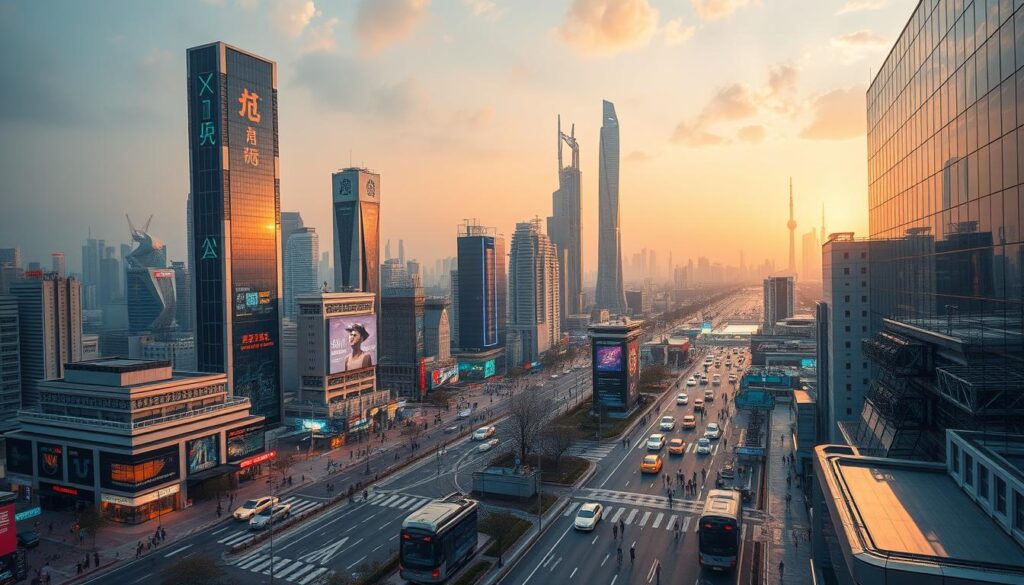
China’s academic institutions are shaping the future of artificial intelligence through groundbreaking research and innovation. Universities like Tsinghua University are at the forefront, driving technological breakthroughs and fostering talent development22. This focus on education and research has positioned China as a global leader in AI advancements.
The world is taking notice of China’s rapid progress in AI infrastructure. High-performance computing centers and state-backed laboratories are supporting large-scale projects, enabling significant advancements in machine learning and natural language processing22. These facilities are a testament to China’s commitment to cutting-edge technology.
Talent development is another critical area of focus. Training programs and university curricula are evolving to meet the demands of the AI industry. For example, the AI Capacity-Building Action Plan aims to enhance AI literacy and strengthen personnel training, ensuring a skilled workforce23.
Collaborative research is also driving progress. Cross-sector partnerships between universities, private companies, and government agencies are fostering innovation. The National AI Open Innovation Platform, developed by the National AI Team, provides open access to AI datasets and resources, encouraging collaboration22.
International comparisons highlight China’s rapid rise in AI. With over 4,500 AI companies, China accounts for 15% of the world’s total AI firms22. This growth is supported by significant investments, with 23% of funding directed toward AI-related companies over the past decade22.
For more insights into China’s AI development model, explore this detailed analysis.
Case Studies: Chinese Firms Leading AI Innovation

Chinese firms are redefining innovation in artificial intelligence, showcasing the nation’s growing influence in the global tech arena. Companies like Zhipu AI and emerging startups are leveraging cutting-edge technologies to compete on a global scale. These firms are supported by robust government initiatives and strategic investments, ensuring their continued growth and impact.
Zhipu AI and Emerging Startups
Zhipu AI exemplifies the power of innovation in China’s tech landscape. Emerging from Tsinghua University, the company has developed advanced large language models (LLMs) that rival global competitors. With over 40 LLMs approved for public use in the past six months, Zhipu AI is at the forefront of this transformation24.
Startups are also making significant strides. Moonshot AI, for instance, updated its Kimi chatbot to handle up to two million Chinese characters via the context window, showcasing its commitment to pushing technological boundaries24. These firms are not only narrowing the gap with international players but also setting new benchmarks for innovation.
Government Support and Investment Trends
The Chinese government plays a pivotal role in fostering AI innovation. State-directed funds and policies provide the necessary power to drive growth while mitigating risk. For example, the Cyberspace Administration of China (CAC) has granted operational licenses to over 1,432 public-facing AI-driven applications, ensuring ethical development24.
Investment trends highlight the commitment to AI advancement. Baidu’s generative AI and foundation models accounted for 656 million renminbi of its total 2023 fourth quarter revenue, reflecting the sector’s economic potential24. Similarly, Alibaba’s Qwen model is being used by 90,000 enterprises across various sectors, demonstrating widespread adoption24.
| Company | Key Innovation | Impact |
|---|---|---|
| Zhipu AI | Advanced LLMs | Competing globally with 40+ approved models24 |
| Moonshot AI | Kimi Chatbot | Handles two million Chinese characters24 |
| Baidu | Generative AI | 656M renminbi in Q4 2023 revenue24 |
| Alibaba | Qwen Model | Used by 90,000 enterprises24 |
These case studies underscore the power of Chinese firms in driving AI innovation. With government support and strategic investments, they are well-positioned to lead globally. However, challenges like export controls and data availability remain significant risk factors25.
Comparative Insights: U.S. vs. Chinese AI Strategies

The U.S. and China are charting distinct paths in artificial intelligence, each leveraging unique strengths to shape the global tech landscape. While the U.S. excels in foundational research and commercialization, China’s extensive regulatory initiatives create a different innovation ecosystem26.
Export Controls and Compute Challenges
Export controls and compute challenges significantly impact both nations’ AI development. The U.S. restricts the export of advanced semiconductors, limiting China’s access to critical hardware27. This has forced China to focus on domestic alternatives, such as Huawei’s Ascend processors, which reduce reliance on foreign technology26.
Compute power remains a critical factor. The U.S. leads in high-performance computing infrastructure, enabling breakthroughs in generative AI27. China, however, is rapidly closing the gap with investments in state-backed laboratories and cloud computing platforms26.
Innovation Ecosystems and Market Capitalization
The U.S. innovation ecosystem thrives on private investment and academic collaboration. In 2020, U.S. AI venture capital funding reached $27.6 billion, accounting for 82% of global investment27. This financial backing supports cutting-edge projects like OpenAI’s GPT series, which has set new benchmarks in generative AI26.
China’s approach emphasizes government support and large-scale deployment. The Chinese government’s 2017 New Generation AI Development Plan aims to make the nation a global leader by 203026. This strategy has led to rapid advancements in sectors like surveillance, smart cities, and industrial automation26.
Market capitalization reflects these differences. U.S. firms dominate in foundational research, while Chinese companies excel in commercialization and application26. For example, Baidu’s generative AI models generated 656 million renminbi in Q4 2023 revenue, showcasing the economic potential of China’s AI sector27.
Both nations share a strong interest in maintaining technological leadership. The U.S. focuses on innovation and talent retention, while China prioritizes regulatory frameworks and large-scale deployment26. These contrasting strategies highlight the evolving dynamics of global AI competition.
For more insights into the impact of AI on business strategies, explore this detailed analysis.
Global Influence of China’s AI Ecosystem and Export Strategies

China’s artificial intelligence ecosystem is increasingly shaping global technology standards, influencing markets far beyond its borders. The chinese government has played a pivotal role in this expansion, with policies like the “New Generation Artificial Intelligence Development Plan” aiming to establish global leadership by 20305.
Export strategies are a key component of China’s global influence. By leveraging advanced models like Baidu’s Apollo project and Tencent’s AI medical imaging, China is exporting cutting-edge technologies to international markets5. These innovations are not only transforming industries but also setting new benchmarks for AI adoption worldwide.
The united states and other nations are closely monitoring China’s advancements. Export controls on advanced semiconductors have been implemented to limit China’s access to critical hardware, yet China continues to innovate with domestic alternatives like Huawei’s Ascend processors22.
Geopolitical dynamics are also at play. The chinese government’s focus on large-scale deployment and regulatory frameworks has created a unique innovation ecosystem. This approach contrasts with the U.S.’s emphasis on foundational research and private investment5.
- China’s AI ecosystem is influencing global technology standards.
- Export strategies are driving cross-border adoption of AI models.
- The united states is responding with export controls and competitive strategies.
- Geopolitical ramifications are shaping the future of AI innovation.
For more insights into how AI is transforming industries, explore this detailed analysis.
Future Opportunities in China’s AI Market
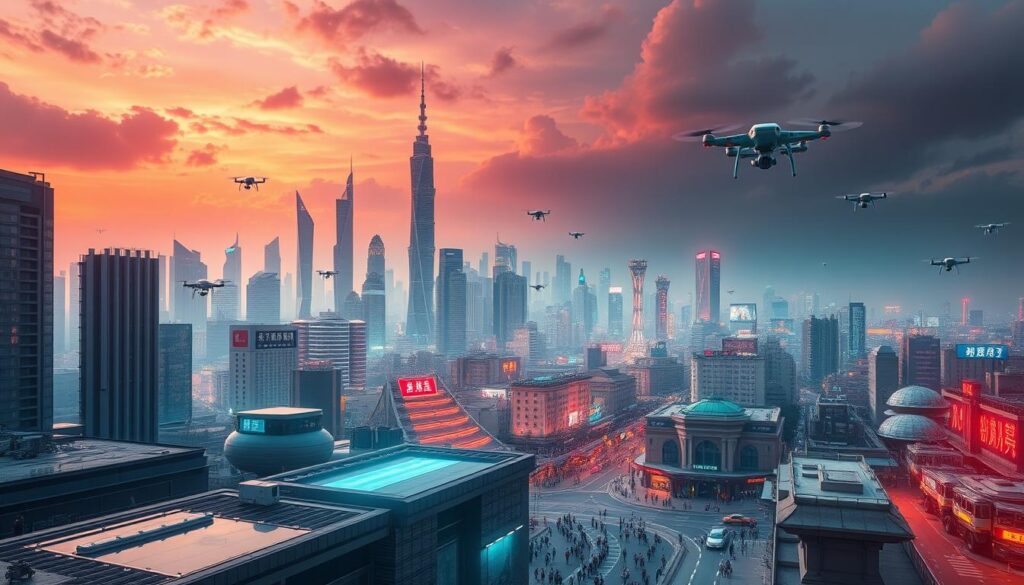
The future of China’s tech sector is being reshaped by groundbreaking advancements in artificial intelligence, offering unprecedented opportunities for growth and innovation. By 2030, the market is projected to generate up to $154.638 billion in annual revenue, driven by robust research and strategic investment6.
Emerging opportunities are being fueled by data-driven insights. The Cyberspace Administration of China has approved over 180 large language models for public use, showcasing the nation’s commitment to innovation6. This focus on datum and research is unlocking new potential across industries.
Strategic investment is accelerating market growth. In March 2024, Beijing announced a 10% increase in national R&D spending, further supporting AI advancements6. This financial backing is driving breakthroughs in sectors like healthcare, finance, and smart manufacturing.
Key areas poised for expansion include:
- Generative AI models, with Baidu’s ERNIE Bot holding an 11.5% market share among domestic users9.
- Industrial automation, where China deployed nearly 300,000 robots in 2024, far surpassing other nations6.
- Smart home technologies, exemplified by Haier’s HomeGPT, which enhances user experiences with advanced natural language processing9.
Both private and government investment are playing pivotal roles. The Chinese government’s focus on building a science and technology powerhouse by 2035 is driving innovation6. Meanwhile, private funding in generative AI surged from $650 million in 2023 to $3.15 billion in 2024, reflecting growing confidence in the sector9.
For more insights into how AI is transforming industries, explore this detailed analysis.
China’s AI market is not just expanding—it’s evolving. With a focus on datum, research, and investment, the nation is poised to lead globally, unlocking new opportunities and reshaping the future of technology.
Challenges and Risks in China’s AI Regulatory Landscape
Export controls and chip shortages are reshaping the landscape of China’s tech ambitions. Despite rapid growth, the sector faces significant hurdles that test its ability to innovate and compete globally28.
One of the most pressing challenges is the availability of advanced chips. Export restrictions have limited access to critical hardware, forcing reliance on domestic alternatives like Huawei’s Ascend processors29. This impacts AI model training and development, slowing progress in key areas.
Regulation also plays a dual role in shaping the industry. While measures like the AI Safety Governance Framework ensure ethical development, they introduce compliance complexities28. Companies must navigate strict rules on data usage, transparency, and safety, which can constrain innovation.
Emerging technology introduces new vulnerabilities. Deep synthesis and generative AI, while transformative, pose risks of misuse, such as misinformation and cyberattacks29. Regulatory frameworks aim to mitigate these risks but often lag behind technological advancements.
Key challenges include:
- Limited access to advanced chips due to export controls28.
- Complex compliance requirements under evolving regulations29.
- Risks from emerging technology, including deepfake misuse and data breaches28.
For companies, operating in this environment requires balancing innovation with adherence to strict rules. The Chinese government’s focus on ethical AI development ensures long-term sustainability but also increases operational risks29.
Looking ahead, managing these challenges will require adaptive strategies. Collaboration between policymakers, industry leaders, and researchers is essential to foster innovation while addressing risks. For more insights into China’s evolving regulations, explore this detailed analysis.
Forecasting Long-term Trends: Technology and Innovation Ecosystem
The future of China’s tech sector is being reshaped by groundbreaking advancements in artificial intelligence, offering unprecedented opportunities for growth and innovation. Forward-looking analyses predict a consolidation in the industry, with a sharper focus on long-term innovation30.
Chinese firms are evolving their strategies to stay competitive in this dynamic ecosystem. Companies like Tencent are leading with models like Hunyuan-Large, which boasts 389 billion parameters and 52 billion activation parameters, capable of holding up to 256,000 tokens30. This showcases the depth of innovation within the sector.
Talent development is a cornerstone of sustainable growth. Initiatives like the AI Capacity-Building Action Plan aim to enhance AI literacy and strengthen personnel training, ensuring a skilled workforce6. These efforts are crucial for maintaining China’s position as a global leader in AI.
Consolidation among firms is expected to redefine market leadership. As smaller companies merge or are acquired, the industry will see a shift towards more integrated and efficient operations. This trend is driven by the need to pool resources and mitigate risks, especially in the face of export controls and chip shortages30.
The balance between cutting-edge research and commercial application remains a key focus. While models like DeepSeek-V2, with 236 billion total parameters, push the boundaries of research, there is also a strong emphasis on converting these innovations into economically productive applications30.
Looking ahead, the next decade presents both opportunities and challenges. The deployment of AI at the edge, for instance, offers faster response times and greater data privacy, but also requires balancing computational and memory constraints30. These factors will shape the future of China’s AI landscape.
| Trend | Impact |
|---|---|
| Consolidation | Redefines market leadership and operational efficiency |
| Talent Development | Ensures a skilled workforce for sustainable growth |
| Edge AI Deployment | Offers faster response times and greater data privacy |
| Research vs. Application | Balances cutting-edge innovation with commercial viability |
In summary, China’s ecosystem is poised for significant transformation. With a focus on talent development, strategic consolidation, and innovative research, the nation is well-positioned to lead globally in the next decade6.
Conclusion
The evolution of technology in this country reflects a blend of innovation and strategic foresight. From market trends to regulatory policies, diverse factors shape its dynamic landscape. The integration of advanced resources and robust strategies drives growth, ensuring a balance between technological breakthroughs and ethical oversight.
Key initiatives, such as DeepSeek’s cost-efficient models, highlight the potential for reducing reliance on high-end hardware31. This shift not only lowers costs but also fosters broader adoption across industries. Meanwhile, regulatory frameworks ensure responsible development, addressing risks like misinformation and data breaches32.
Looking ahead, the global implications of these advancements are profound. As competition intensifies, collaboration and adaptive strategies will be crucial. Understanding these dynamics offers valuable insights for both domestic and international contexts, paving the way for sustainable innovation.
FAQ
What are the key trends in China’s artificial intelligence industry?
How does the Chinese government regulate AI development?
What are the Deep Synthesis Provisions, and how do they impact AI?
Which sectors in China are leveraging AI applications?
How does China’s AI market compare to the U.S.?
What role do Chinese firms play in AI innovation?
What are the future opportunities in China’s AI market?
What challenges does China face in its AI regulatory landscape?
How does China’s AI ecosystem influence global markets?
What is the forecast for long-term trends in China’s AI industry?
Source Links
- Exploring China’s Leading AI Hubs: A Regional Analysis
- An Analysis of China’s AI Governance Proposals | Center for Security and Emerging Technology
- What Are China’s AI Tigers? What You Need to Know About China’s AI Start-Ups
- China’s AI Policy & Development: What You Need to Know
- Assessing China’s AI development and forecasting its future tech priorities
- How Innovative Is China in AI?
- Greater China Insights—China’s AI Growth Multiplier
- China And AI In 2025: What Global Executives Must Know To Stay Ahead
- The Evolving AI Regulatory Landscape in Asia: What Compliance Leaders Need to Know
- DeepSeek and China’s AI Regulatory Landscape: Rules, Practice and Future Prospects | JD Supra
- Navigating China’s regulatory approach to generative artificial intelligence and large language models | Cambridge Forum on AI: Law and Governance | Cambridge Core
- Deep Synthesis Not Deepfake: How AI Compliance Works In China
- China’s Artificial Intelligence Law: Everything You Need to Know
- China’s AI Breakthrough Signals a New Era of Tech Innovation
- China Is Rapidly Becoming a Leading Innovator in Advanced Industries
- China’s AI-Powered Industrial Revolution: Transforming Manufacturing and Beyond!
- China’s advances could boost AI’s impact on global GDP
- Market Size
- China’s AI Revolution: The Global Tech Power Shift – The Geopolitics
- DeepSeek: how China’s embrace of open-source AI caused a geopolitical earthquake
- China’s AI Skills Training: A Job Market Game Changer
- China’s Generative AI Ecosystem in 2024: Rising Investment and Expectations
- The Rise of DeepSeek: China’s Answer to Silicon Valley’s AI Dominance
- China and the U.S. in the Race for Artificial Intelligence: A Comparative Analysis
- China and the U.S. produce more impactful AI research when collaborating together – Scientific Reports
- China-releases-AI-safety-governance-framework | DLA Piper
- AI Governance in a Complex and Rapidly Changing Regulatory Landscape: A Global Perspective – Humanities and Social Sciences Communications
- The Future Of Technology: Generative AI In China
- China’s AI Breakthrough and the Global Race for Artificial Intelligence Supremacy
- China’s AI Dominance: The US’s Mass Production Dilemma







